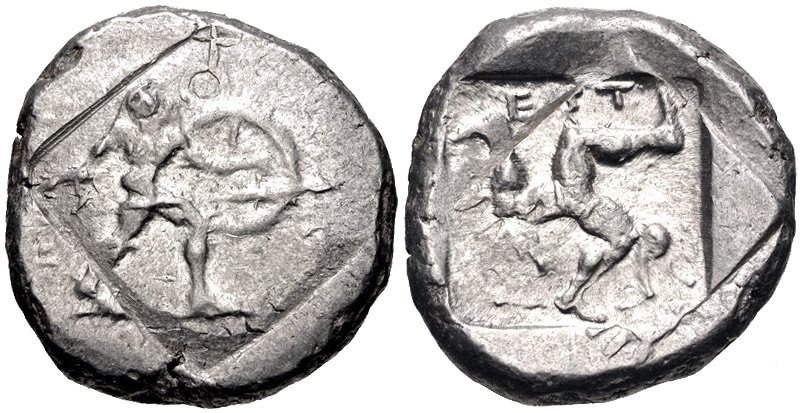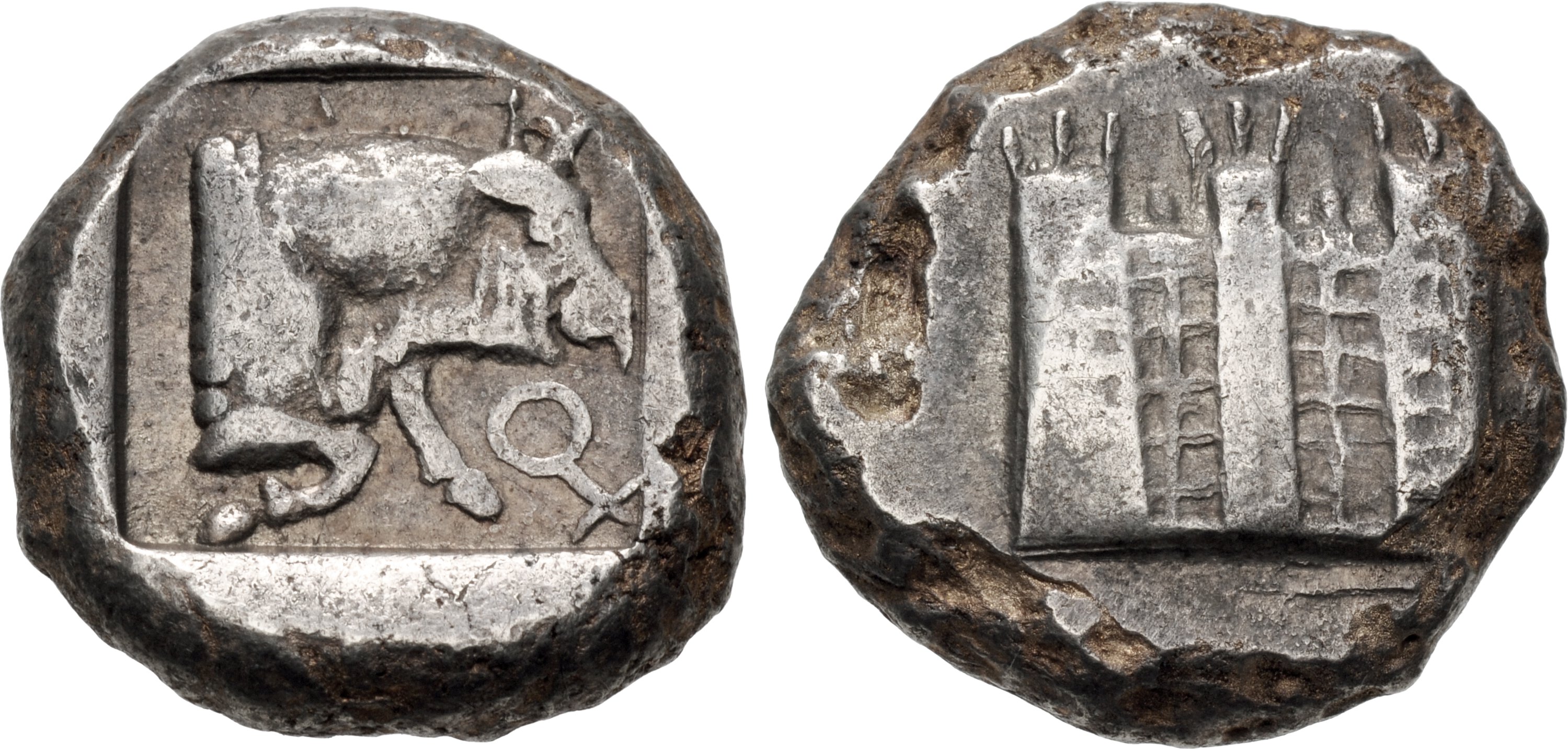2541 - Aspendus (double siglos hoplite/triskeles) over Cilicia (uncertain mint) (city wall/bull) (CNG, EA 432, Nov. 2018, 82)
From SILVER
465 BCE - 430 BCE | ΕΣΤ
Location/history
| Sale(s)Sale(s) ᵖ: | Classical Numismatic Group, EA 432, 14 Nov. 2018, 82 | |
Overstriking coin
Description
| ObverseInscription or printing placed on the obverse.: | Warrior walking right, naked, wearing helmet, holding spear in right hand, shield attached on left arm. | ReverseInscription or printing placed on the reverse.: | ΕΣΤ (Greek) Triskeles of human legs. Behind, lion crouching left. All within incuse square. |
Mint and issuing power
| MintIdentifies the place of manufacture or issue of a numismatic object.: | Aspendus | Ancient regionAncient region. | Pamphylia | Modern countryModern country: Turkey | AuthorityIdentifies the issuing power. The authority can be "pretended" when the name or the portrait of X is on the coin but he/she was not the issuing power. It can also be "uncertain" when there is no mention of X on the coin but he/she was the issuing power according to the historical sources: | Persian Empire |
Chronology
| FromIdentifies the initial date in a range assigned in a numismatic context. 465 BCE toIdentifies the final date in a range assigned in a numismatic context.. 430 BCE | Classical 480-323 BC |
Physical description
| MetalThe physical material (usually metal) from which an object is made.: Silver |
WeightWeight of the numismatic object (in grams). in grams: 10.9210.92 g <br />10,920 mg <br /> | DenominationTerm indicating the value of a numismatic object. Examples: tetradrachm, chalkous, denarius.: double siglos |
AxisDescribes the directional relationship between the obverse and reverse of a numismatic object.: 66 mm <br />0.6 cm <br /> |
| DiameterDescribes diameter of an object (in mm).: 21.521.5 mm <br />2.15 cm <br /> | StandardStandard.: Persian | ||
References
| Coin referenceReference of the Coin: | Coin series referenceReference to coin series study: | Babelon 1901-19321Babelon 1901-1932, Tome 1, Part 2, p. 526-530, n° 869-70, SNG von Aulock Pamphylien2SNG von Aulock Pamphylien, n° 4484, SNG France 33SNG France 3, n° 12-13 | |
| Coin series web referenceCoin series web references: | |||
Overstruck type
Description
| ObverseInscription or printing placed on the obverse.: | Crenelated city wall with three towers | ReverseInscription or printing placed on the reverse.: | Forepart of bull advancing right, symbol to lower right, all within incuse square |
Mint and issuing power
| MintIdentifies the place of manufacture or issue of a numismatic object. ᵖ: | Cilicia (uncertain mint) | Ancient regionAncient region. ᵖ | Cilicia | Modern countryModern country: Turkey | AuthorityIdentifies the authority in whose name (explicitly or implicitly) a numismatic object was issued. ᵖ: | Persian Empire |
Chronology
| FromIdentifies the initial date in a range assigned in a numismatic context. 465 BCE toIdentifies the final date in a range assigned in a numismatic context.. 430 BCE | Classical 480-323 BC |
Physical description
| DenominationTerm indicating the value of a numismatic object. Examples: tetradrachm, chalkous, denarius. ᵖ: | double siglos |
References
| Coin type referenceReference to coin series study ᵖ: |
Additional data
| Frequency of overstrikesFrequency of overstrikes: | frequent | Level of confidenceLevel of confidence of the identification: | sure |
| RemarksRemarks: | "overstruck on a stater from an uncertain mint in southern Asia Minor (see CNG 109, lot 190 [an unpublished issue]). The presence of the overstrike here suggests why the CNG 109 piece was not previously published--perhaps it was a limited issue that was largely overstruck at a later time (likely a significant reason we often find coins of previously unknown types in archaic hoards" | ||
References
- ^ Babelon, Ernest (1901-1932), Traité des monnaies grecques et romaines, Paris, E. Leroux
- ^ Sylloge Nummorum Graecorum. Sammlung v. Aulock. Pamphylien. 11 Heft (n° 4477-4893), Berlin, 1965.
- ^ Levante, Edoardo [with the collaboration of Peter Weiss] (2001), Sylloge nummorum graecorum. France. 3, Département des monnaies, médailles et antiques : Pamphylie, Pisidie, Lyaconie, Galatie, Paris-Zürich, Bibliothèque nationale de France-Numismatica Ars Classica, XXXIV + 293 p. and 146 pl.

